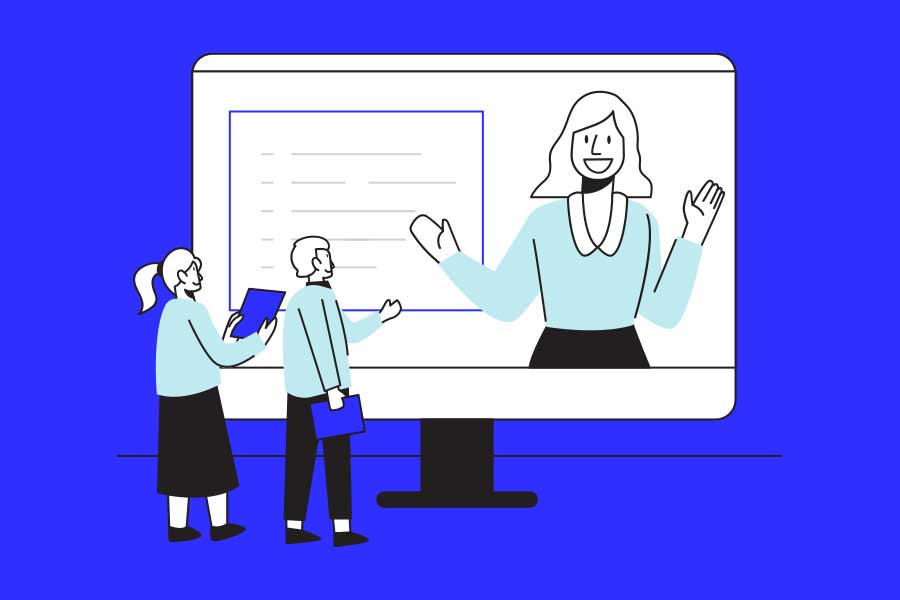While most marketing teams assume referral programs are traditionally for B2C companies, there is actually a ton of value for B2B companies who take on this tactic to acquire new customers.
In this article, we’ll be covering:
- Why B2B companies should consider starting a referral program
- The difference between referrals in B2C vs B2B
- A checklist of things to have in order before you roll this out
- Our list of best practices to give your referral program the best chance of success
- 5 examples of B2B companies with strong referral programs
Let’s get started.
Why start a B2B referral program?
Word-of-mouth marketing is powerful and trusted, but it’s often difficult to predict, track, and influence. A referral program gives your company control of the sharing process.
By setting up how and what customers are saying about you, you can help control the narrative. This course of action can lead to more business, higher customer retention, and new customers joining your ranks.
With a B2B referral program, you not only make it easier for customers to tell others that you exist, but you get to suggest what they say. You can write messages that outline a referral chat – who you are, why the lead should work with you – and then make it so customers can just hit send. This ease of connection makes it more likely that satisfied customers will refer you out to others.
Meanwhile, referrals are easier than ever to track with referral software and automated machine learning. With a B2B business, a referral program can be great to have in place, as you can follow which customers bring in the most new buyers. You can reward your best referrers with bonuses, or tailor the program to better suit clients’ needs in order to bring in even more customers through referrals.
Finally, a referral program can help you use advocate-marketers to increase conversion rates. Leads who have heard about a business through a trusted source are far more likely to sign up with or purchase from a brand. These are considered warm leads. They already know what you do, and a trusted source gave you a recommendation.
Here are some stats from Forbes and Social Media Today that’ll help this all hit home:
- 78% of marketers attest that a B2B referral marketing program program draws in valuable leads
- 54% say the cost per acquisition is lower with B2B referral programs
- Referrals were ranked as the 2nd highest conversion of new business
B2B vs. B2C referrals
There are some key differences between B2B and B2C referrals. Most notably, your audience. While B2C brands are trying to reach a large group of customers, B2B brands are looking for a smaller, more pointed group.
- B2C is reaching the masses: all shoppers or consumers with a need for certain types of products.
- B2B is looking only for businesses that have an immediate need for their company. Therefore, there’s a smaller pool of customers.
The biggest change in this is the motivation of your buyer. While a B2C company might target a consumer’s intrigue or heartstrings to trigger a one-time purchase, B2B products and services are a long-term sale. B2B customers will go through longer, more thorough research processes before they purchase, and they’ve usually done plenty of homework before they approach you. They aren’t looking for a quick fix, but something that will fill a need for years to come.
What to do before you launch a referral program for your B2B company
Your company should meet the following criteria before launching a referral program. You want to make sure that your existing customers and potential new customers get an amazing experience for this to be successful.
Make sure your product/service is worth sharing
It sounds obvious enough, but if you don’t have a product or service that’s trustworthy, your business is going nowhere (whether you have a referral program or not). You need a business model in place that’s worth referring – something your best customers will brag about. Ensure your brand has top-notch products, service, and/or customer service.
One way to validate this is reading what your online reviews say about your brand. You can also conduct an NPS survey (net promoter score) to get a better idea of what clients have to say about you.
Then, once you know people are willing to share, offering a referral reward will only sweeten the pot.
Ensure customer support is ready for more customers
The addition of a referral program could mean fast business growth for your brand. Do you have the infrastructure to take on the higher volume of sales, and support new customers throughout their lifecycle?
Most notably, your customer support team needs to have foundations in place to handle more customers. Can you ship out a higher volume of items efficiently? Onboard customers with the same standard? Continue to offer the stellar services you’ve become known for? Reply to customer calls and emails promptly?
If your new customers will need it from you, it needs to be ready before you open the floodgates. Adding infrastructure after the fact can create a bumpy, less effective process.
Nurture your relationships with your existing customers
How is your relationship with your current customers? What does the buying process look like?
Obviously, you want them to be happy. But a successful referral program requires that your customers are so happy that they actually go out and request for others to join your services. Work on improving relationships with the customers you have now in order to instill their confidence in your brand.
As a B2B business, you have a nuanced relationship with your consumers. Reach out to get to know them and understand their needs. What does each customer-brand need? How can you help them reach their goals?
In addition, this gives you the opportunity to listen to customer feedback and implement their advice. Finally, you can learn what would encourage them to bring a customer referral.
Decide on your target audience: Who will you ask for referrals?
Your target audience will be those who are most likely to send you referrals.
What type of customers do you want on your team? Who is most likely to sing your praises, and who are the brands’ decision makers in your space (e.g. B2B marketing managers? Salespeople? Members of the C-suite?)
Your answer will determine the audience you focus on when you ask for referrals.
Will you target paying customers?
Sure, this seems like another obvious question, but it’s one worth exploring.
First, consider that your paying customers have experienced the full services of your brand. If you offer a free version of your product, these customers went beyond that in order to pay for your full offerings. They have a deeper understanding of what you do, how your products or services fare, and they are continually willing to pay for it.
Consider these customers to be the driving force behind your upcoming referral program.
Your most loyal users?
Next, look at loyal customers.
Who has returned for repeat business? Who leaves reviews online? Who shares positive comments about you on social media? These are your most loyal customers. They’re invested in your brand, making them a great place to go for referrals.
If you sell a product, look at who’s purchased the most or multiple times. If you have a subscription company, consider who’s been signed up for your service the longest. Then take happy reviews into account as well. Loyal customers will share positive reviews online and be willing to stake their name for you in public.
Customers who said they’re willing to promote you?
If someone lets you know they’re willing to promote you, they are almost a sure bet to be a good referral source. You can easily find these customers in a few different ways.
First, like we mentioned above, check for online reviews. If someone mentioned you online, they will be likely to send referrals, too. Those are great prospects for your referral program.
Next, send out an NPS survey. Email customers with a survey asking about their experiences. In it, those who say they’re likely to refer are a great lead for your referral program. Be sure to reach out to these leads and ask them to share your name.
Know the right time to ask for referrals
With B2B customers, it’s best to ask for a referral after someone has had a positive experience with your brand. Asking for leads too soon can be a turn-off, as customers might think you’re just out for a lead. Instead, wait until your customer has felt value within your brand.
Schedule a time to reach out after they’ve been a customer for a certain amount of time. Some key times to reach out are once they’ve been a customer for a few months, or after a satisfying customer experience (this is where your customer success team can be helpful in finding advocates).
If a consumer reaches out about a question or concern and walks away from the experience happily, or if they offer positive and unprompted feedback, these are other great times to ask for referrals.
13 best practices to create a successful referral program
Find more success with your B2B referral program by following these smart and proven best practices. Check them out for yourself in order to build a better program right from the start.
1. Make sharing easy
The easier it is for a customer to share your referral link, the more often it will get shared. It’s as simple as that. Make it easy for your customers to promote the referral program. If the process takes too many steps, it might confuse users or they may become frustrated with the process entirely and move on.
Create a page that’s easy to follow and user-friendly (more on this in #4 below). Using a referral link or referral code is one easy way to share. With the link or code, users can copy and paste or send directly via email in order to get your referral seen.
2. Strategically build your lead form
Strategically build your lead form so that it’s easy to fill out and follow. If you ask too many questions, or include too many fields, a referee or new customer might be less apt to complete it. Keep it short and to the point so that you can obtain the information you need without overwhelming the customer.
Use a streamlined contact form that asks for the referrer’s name and email, as well as the lead’s name and email. You might also add in a space for the lead’s phone number.
Here’s an example of the lead form you’d typically want to ignore (Google can get away with it because… well, they’re Google):

3. Ensure your program messaging is easy to understand
How the referral program works should be clear and to the point.
Referral, reward. Referral, reward. You can use images or graphics to help illustrate this point even further. Remember that your clients are busy, you don’t want to cause any extra work for them. Make it as easy as possible to help close the sale.
Also, what does your referral message say to new customers? What, if any, referral incentives are on offer for them? Keep it short and informative, and allow them to learn what you do and why they should choose your brand.
4. Design a concise CTA

It’s important to have a clear CTA at the end of your referral program messaging. A CTA – call-to-action – tells your customer exactly what it is that you want them to do. Sign up here, click to learn more, sign up and earn. All of these examples can entice new leads to click and sign up through your referral program.
Consider the design, too. Your CTA should be large and easy to find. Think about using a button for easy clicking and better visibility.
5. Motivate members to refer with the right rewards
Customers will be the most likely to refer others when they are intrigued by the reward on the other side. Find out what works for your customers – what excites them? You can do this with customer research or through the survey methods we discussed earlier.
B2B consumers are likely to be motivated by free or upgraded services that will help their business, dollars off of your product, or perks unrelated to your product that could assist them in their career.
Remember that B2B programs are a little different than their B2C referral counterparts. You’ll want to reach your customers in a way that speaks to them. Consider the professional market, and your particular industry, and how you can entice new leads.
Company swag is a great way to go if you offer unique ones, while direct rewards like cash or gift cards can also entice your market. Keep in mind that experiences like tickets for professional events can also pique your key market’s interest.
Find out what it is that will most motivate your customers and offer it in exchange for their successful referral. This is one of the most effective ways to motivate your customers into bringing in new and successful leads.
6. Include an FAQ page
What questions do you think your customers will most regularly ask about your referral program? Consider what these might be, or take note of what questions customers are already asking most often about your referral program.
From there, you can create an entire page that answers their questions, or answer them directly on the referral signup page. This will better inform your customer base and allow them a single stop for their answers. No waiting or getting frustrated with a wait time – instead, they can head to a single page that answers the most common questions that reach your brand.
Answers should be quick and easy to read – informative so customers remain excited about the problem, but not so long or complicated that they get bored or confused. Keep it concise and light to keep your leads in the know about your referral program.
7. Promote your B2B referral program
Once your referral program is up and running, it’s time for one of the most important steps – promoting it.
There are several ways in which you can promote your program. Common channels typically include email marketing, social channels, and messaging with clients.
Target your ideal audience, as discussed above. With a targeted campaign, you can offer personalized connections with each customer. Emails, phone calls, or texts can be used to reach customers and personalize the message to them (i.e. you can tell them they were personally picked).
In addition, you should also promote the program on your website, with a landing page and clear, concise text that explains the program. Finish it off with your visual CTA, and you’re on your way to a successful referral program.
Don’t forget to have fun too. Yes, you’re a B2B company, but a little flair can catch customers’ attention and get you on your way to landing new prospects. You don’t need to be another boring B2B company!
An easy way to add fun can come in the form of pictures, your message – by adding humor or personalization – or with a game. Through gamification, you can add a competitive aspect to your program. This can further entice people to join in. After all, who doesn’t love friendly competition?
8. Personalize how you connect with referred leads
Next, you’ll need to adjust how you connect with your potential customers. Consider having someone from your sales team call them personally. This is a great time to learn about the company’s business. Ask them about nuances, as well as any questions or concerns they might have about working with your business.
This extra step will not only show that your business cares, but it will put you in a good position to better meet their needs and adapt to their wants and concerns for the future.
It’s also a good idea to reach out to the referring customer before you call to get any important background information that could help close the sale. In most cases, you’ll gain smart, relevant information without having to dig deeper with the client.
9. Let your customers help you craft a referral message
Like with a B2C referral program, with your B2B program, you will want to provide the referring customer with a pre-drafted message. Write up something you want them to convey, including a message that tells who you are and what you have to offer to the new client.
However, you should also give clients the opportunity to change the message themselves. Allow customers to make the message personal to their contact. A message that’s more personal has a better chance at finding intrigue.
Allow customers to explain what it is that they love about your business and why they recommend it to others. Short message options are also great for enticing leads, including those that go out via social media or text.
10. Personally call or email referred leads
Pretty straightforward, right? Yet it’s a method that’s often overlooked. As mentioned above, personally calling or emailing leads can make all the difference. This shows that you took the time and effort to reach out and connect with the customer on a personal level. It also provides you with personalized information that will help you to better connect with your customers.
Getting to know your customers on a deeper level can be beneficial on many fronts. But most notably, it creates trust that will allow them to trust you enough to sign up with your brand.
11. Properly handle referred leads
Don’t let referred customers fall through the cracks. Have a proper plan in place where you can field and pursue all of your leads. This is the only way to ensure that your potential customers will be followed up on and taken care of.
Your marketing team, sales team, and customer support team should all have a clear plan of how they should handle each referral lead. First, scan the referral to ensure it will be a good fit for your company. You don’t want to pour too much time or too many resources into a lead that won’t pan out. Therefore, by screening them upfront, you’ll know if the lead will be a good one for the brand.
Then, after a pre-screening process, it’s time to make sure no one falls through the cracks. Doing so could cause a client to lose faith in your brand (and potentially cost you a sale.) Stay on top of leads so you can ensure your company is putting its best efforts forward at all times.
12. Consider automating your program
Creating a referral program manually can be tough. That’s why it can be beneficial to use a software program that does the work for you. Automated software can keep track of leads, who sent them, and where they are in the signup process. This type of automated software can make the referral process far easier to close deals with. And it can give you peace of mind that your referrals are working for you – and that no mistakes are being made along the way.
Take out the guesswork and automate your referral program by adding in referral software.
13. Track your progress towards goals
How can you tell whether your referral program is a success? Setting and tracking progress towards measurable goals is key.
One key referral program metric you should track is conversion rate (the number of referred leads who ultimately make a purchase, relative to the total number of referred leads). You might also track the percentage of customers who have referred peers, and the percentage of customers who have made a successful referral.
To easily track your progress towards your conversion rate goal, and other goals, referral software is key. Since these platforms already come with built-in analytics, tracking features, and referral link generation, they make it much easier to measure your return on investment.
5 examples of effective B2B referral programs
Now let’s take a look at some referral programs that have been successful for some of the top B2B companies.
Gusto
Gusto is an all-in-one payroll, benefits and HR software solution that helps businesses manage their employees with ease. It simplifies the complexities of taxes, compliance and benefits so business owners can focus on running their business.
As part of Gusto’s referral program, you can earn a $300 visa gift card for every referral you bring in, and the person you refer will also get a $100 gift card.
Gusto does a great job of highlighting their referral program by including a callout in customer dashboards under “Refer & earn”, as well as in the Personal details dashboard of every account.
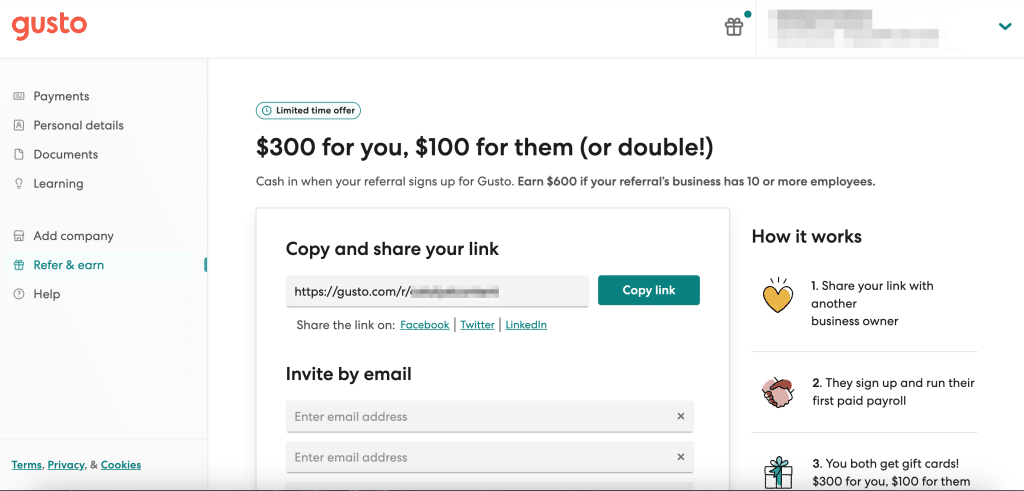
Lasso
Lasso makes tools for bloggers and affiliate marketers to promote products on their websites. They’re an example of how you can actually make your referral program an affiliate program.
What we like the most about Lasso’s page here is they make the copy fun, they put the “what’s in it for you” front and center at the top, and they give you a ton of details about how the program works (including a solid use of FAQ’s at the bottom).

Google G Suite (Google Workspace)
Google’s business system that includes email, chat, video calls, and more has grown through its B2B marketing referral program.
Businesses that bring in successful referrals get flat cash in return for their efforts. The tiered program offers more when members sign up for a higher level of G Suite services.
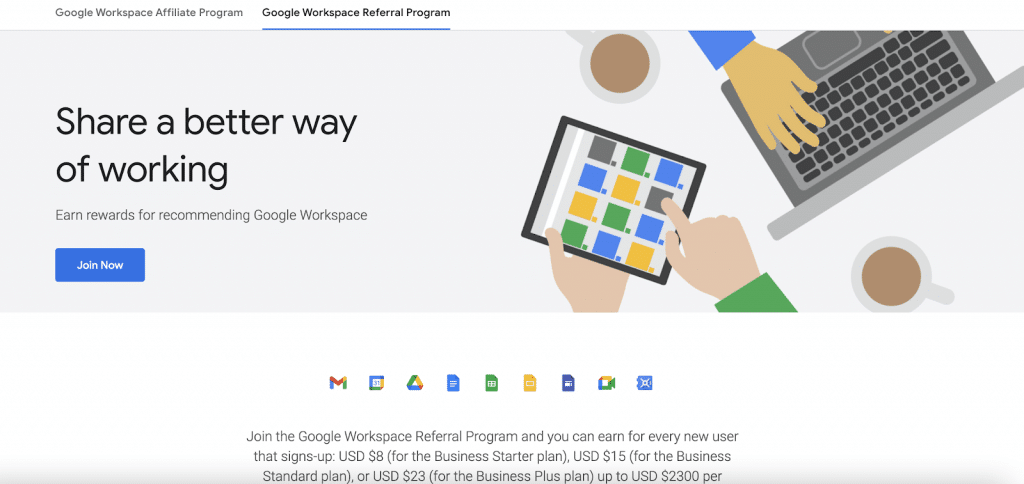
Bench
Meanwhile, Bench is a SaaS company that offers relief funding. For every referral that joins them as a new customer, the referring client receives a $150 Visa gift card and a free month of bookkeeping.
There are no limits on the number of leads a customer can bring in, either. So, clients can keep sending in new B2B leads and earning funds back for their efforts.
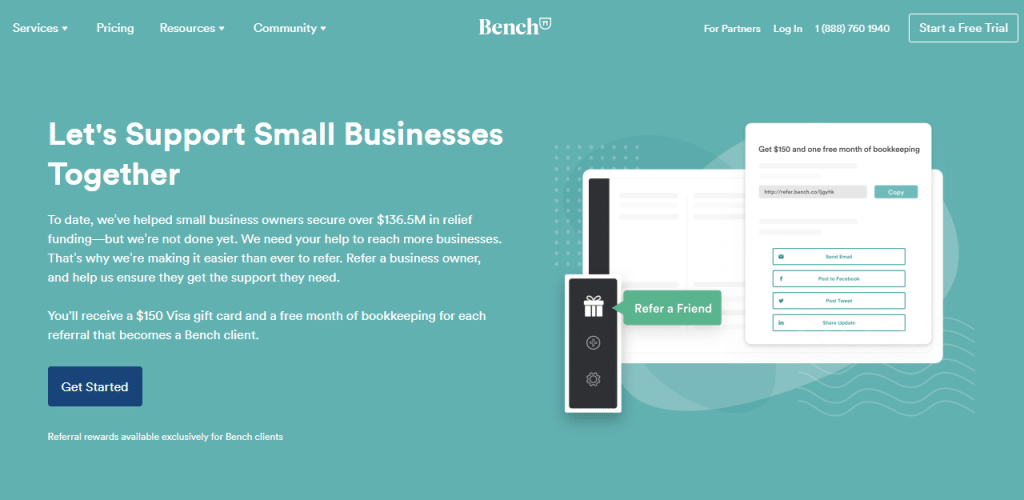
GetResponse
GetResponse is a marketing SaaS platform that helps brands grow through email campaigns. Their program works in tiers, and offers different rewards at each level.
For a single referral, customers can earn $30 off of their bill (this reward is double-sided, so referred customers earn as well). But after bringing in three successful referrals, customers earn access to a digital marketing certification course. Better still is they get to choose the course that they access as a reward.
This is a great example of offering something of value to referring customers. GetResponse can uniquely offer the courses, and provide significant value to the customer in the process.
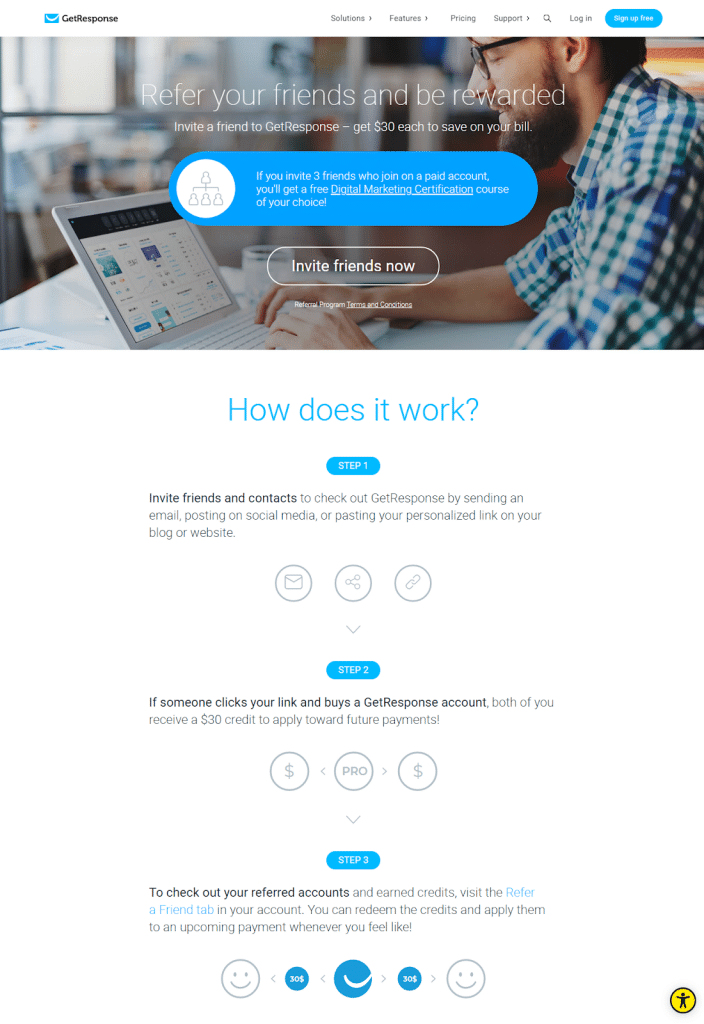
If you’re also a B2B SaaS, check out our dedicated SaaS referral program guide.
Wrapping Up
B2B referral marketing programs can be a great way to advance your marketing efforts. Reaching company-based customers can be slightly different than B2C formats, but by taking the time to make connections and understand what your clients need, you can land more customers and convert leads into loyal customers.
And once you’ve set up your B2B referral program, don’t just leave it be. Rather, A/B test your program, then refine it based on which structures best motivate your advocates and leads. The detailed tracking features of referral software will help you with this important process.
